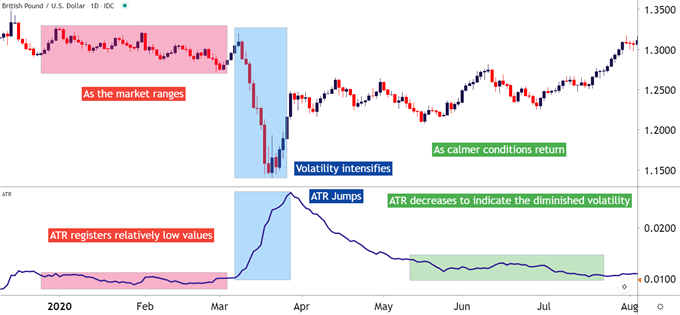
MEASURING VOLATILITY: TALKING POINTS
- Volatility is the measurement of value variations over a specified time period.
- To measure volatility, the Common True Vary (ATR) and Volatility Professional indicators are used.
Technical Evaluation can carry a major quantity of worth to a dealer.
Whereas no indicator or set of indicators will completely predict the longer term, merchants can use historic value actions to get an thought for what could occur sooner or later.
On this article, we’re going to take the dialogue of technical evaluation a step additional by specializing in one of many major components of significance in figuring out market situations: Volatility.
THE RISK OF VOLATILITY
The attract of high-volatility situations might be apparent: Larger ranges of volatility imply bigger value actions, and bigger value actions imply extra potential alternative but additionally extra attainable danger.
Merchants have to see the total spectrum of this situation: Larger ranges of volatility additionally imply that value actions are even much less predictable. Reversals might be extra aggressive, and if a dealer finds themselves on the incorrect facet of the transfer, the potential loss might be even increased in a high-volatility setting because the elevated exercise can entail bigger value actions in opposition to the dealer in addition to of their favor.
AVERAGE TRUE RANGE
The Common True Vary indicator stands above most others in relation to the measurement of volatility. ATR was created by J. Welles Wilder (the identical gents that created RSI, Parabolic SAR, and the ADX indicator), and is designed to measure the True Vary over a specified time period.
True Vary is specified because the better of:
- Excessive of the present interval much less the low of the present interval
- The excessive of the present interval much less the earlier interval’s closing worth
- The low of the present interval much less the earlier interval’s closing worth
As a result of we’re attempting to measure volatility, absolute values are used within the above computations to find out the ‘true vary.’ So the most important of the above three numbers is the ‘true vary,’ no matter whether or not the worth was damaging or not.
As soon as these values are computed, they are often averaged over a time period to easy out the near-term fluctuations (14 durations is frequent). The result’s Common True Vary.
Within the chart under, we’ve added ATR as an instance how the indicator will register bigger values because the vary of value actions will increase:
GBP/USD (JAN-AUG 2020) WITH ATR APPLIED

HOW TO USE ATR
After merchants have realized to measure volatility, they’ll then look to combine the ATR indicator into their approaches in one in all two methods.
- As a volatility filter to find out which technique or method to make use of
- To measure danger outlay, or attainable cease distance when initiating buying and selling positions
USING ATR AS A VOLATILITY FILTER
Merchants can method low-volatility environments with one in all two completely different approaches.
Merely, merchants can search for the low-volatility setting to proceed, or they’ll search for it to alter. Which means, merchants can method low-volatility by buying and selling the vary (continuation of low-volatility), or they’ll look to commerce the breakout (enhance in volatility).
The distinction between the 2 situations is big; as range-traders need to promote resistance and purchase assist whereas breakout merchants need to do the precise reverse.
Additional, range-traders often have the posh of well-defined assist and resistance for cease placement; whereas breakout merchants don’t. And whereas breakouts can doubtlessly result in large strikes, the likelihood of success is considerably decrease. Which means that false breakouts might be plentiful, and buying and selling the breakout usually requires extra aggressive risk-reward ratios (to offset the decrease likelihood of success).
USING ATR FOR RISK MANAGEMENT
One of many major struggles for brand spanking new merchants is studying the place to put the protecting cease when initiating new positions. ATR will help with this aim.
As a result of ATR is predicated on value actions out there, the indicator will develop together with volatility. This permits the dealer to make use of wider stops in additional risky markets, or tighter stops in lower-volatility environments.
The ATR indicator is displayed in the identical value format because the foreign money pair. So, a price of ‘.00458’ on EUR/USD would denote 45.8 pips. Alternatively, a studying of ‘.455’ on USDJPY would denote 45.5 pips. As volatility will increase or decreases, these statistics will enhance or lower as nicely.
Merchants can use this to their benefit by putting stops based mostly on the worth of ATR; whether or not that be an element of the indicator (resembling 50% of ATR) or the direct indicator learn itself. The important thing right here is that the indicator learn can be conscious of current market situations, permitting for a component of adaptation by the dealer using the indicator of their method.